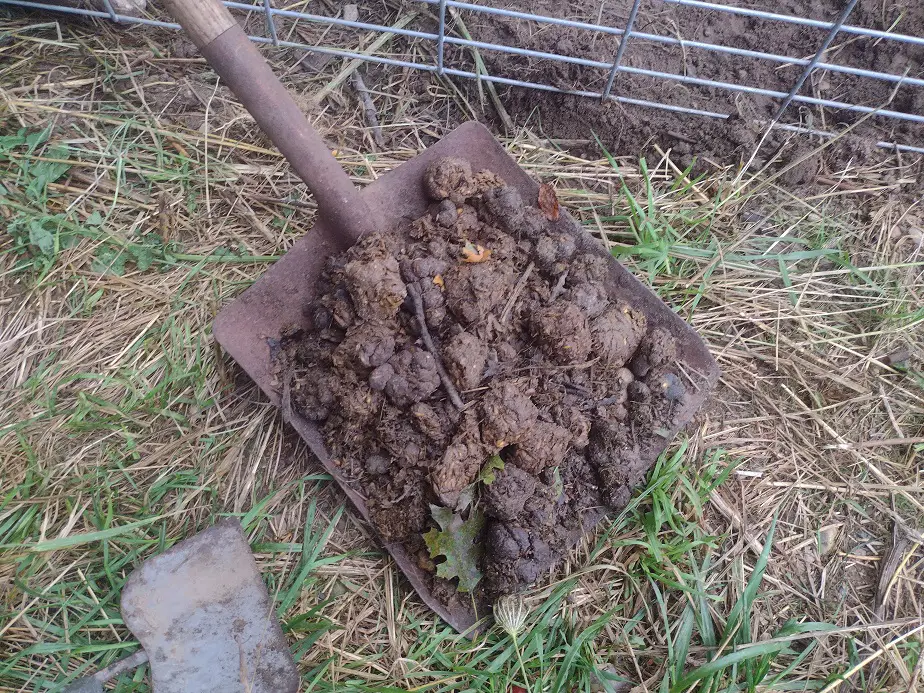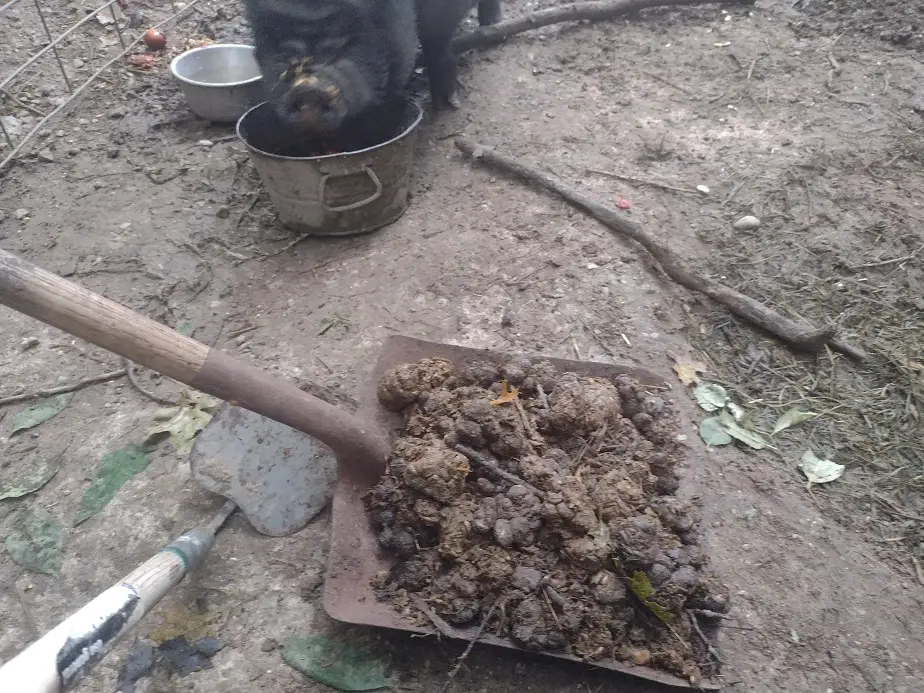I fertilize our 1/2 acre garden with mostly manures. Do it right and it works.
Manure can be spread fresh, dry, or aged depending on the season. Very fresh manures can potentially damage a plant’s leaves by drawing out moisture from a plant. Manures should be applied carefully during the growing season and heavily in the fall and early spring.
Manures can feed your garden, but they can also cause problems with nutrient availability if you use too much.
How Manure Helps Gardens
Manure consists of both solid and liquid waste from livestock, often mixed with bedding material such as straw, wood shavings, or sawdust. I would call manure both an amendment and a fertilizer. It definitely has good fertilization qualities, but it includes a lot of solid waste organic matter.
The organic matter helps to slow down water movement in the soil. It keeps the water from rain and irrigation from running straight through the ground and dissipating away. That water-holding action helps to keep your fertilizer from leaching through the soil and being wasted.
So, it’s more than just fertilizer for sure. It’s both fertilizer and an amendment, with the exception of commercial poultry manure. That stuff has less organic matter and can be considered an organic fertilizer.
Amendments go beyond the actions of fertilizers. They don’t directly add to the necessary nutrients the plants need, at least not much. Manures can certainly add all the macronutrients, and most micronutrients the plants need, but they don’t do it right away.
Manures all contain a fairly well-rounded ratio of N-P-K (Nitrogen-Phosphorus Potassium) for general plant growth and development. Where it gets tricky is that different manures have different amounts of N-P-K. and the Nitrogen in manure is particularly volatile.
Depending on how fresh or old the manure is, and how quickly it is mixed with the soil after it’s spread, up to 50% of the Nitrogen in manure can be lost.
Nitrogen Content in Manure
There are two main types of nitrogen in manure. The nitrogen from urine, which is readily water soluble, and the nitrogen in the semi-digested, solid matter; which is not water-soluble. The water-soluble, nitrate form of nitrogen is quickly carried by rain and irrigation through the soil.
It is drawn to the plant’s root system, where it is immediately usable to the plant. However, if the manure isn’t mixed in the soil soon after spreading it, almost all of that good, immediately usable nitrogen can turn to gas and be lost. Particularly so on hot days.
The remaining forms of nitrogen have to be broken down first. As the organic matter decomposes, the remaining nitrogen goes through a chemical change and forms a chemical compound known as nitrate. As stated before, nitrates are water soluble and in a form the plants can actually use.
Manures steadily release this form of nitrogen as they continue to break down in the soil over a period of several years. As more solids break down, less nitrogen is left available for the next year.

Which Manures are Stronger?
Most of the information for the value standards of the N-P-K in manures comes from the commercial farming industry. Of course, you can use manure from your hobby farm, or the lady across town who raises dozens of chickens.
Farms in the commercial industry tend to raise livestock in much the same manner across the U.S. That means the manure from different farms will have similar N-P-K values within the commercial industry. Whereas small hobby farms and backyard homesteaders all do things differently.
They use tend to use a lot more bedding, and let the manure pile up for a lot longer than bigger farms. Because of that, it tends to have less Nitrogen than commercial farms.
Since horses and rabbits aren’t considered part of the commercial industry today, the information on them mostly comes from small farms and hobbyists. The problem with horse manure is that it’s usually mixed with bedding, and different horse owners use vastly different amounts of bedding.
Rabbit manure on the other hand generally contains little bedding material, and most rabbits are fed similarly. So, rabbit manure has the most consistent N-P-K values between different sources and will most closely reflect the values listed in this article.

How strong are different manures?
I’ve put together NPK values of common manures as averaged by referencing a dozen published research reports within the United States. This is listed as a percentage N-P-K of the dry matter (all water removed for testing) of the manure by weight.
- Meat chicken manure (commercial) : 3.1-1.4-1.7
- Laying chicken manure(commercial) : 2-1-0.9
- Dairy cow manure (commercial) : 0.7-0.2-0.6
- Horse manure: 0.7-0.1-0.4
- Rabbit manure: 2-1-0.7
If you’ve seen other articles I’ve written about manure, you may see slightly different numbers reported for these manures. That’s because it’s all pretty variable and not at all exact. However, the scale of comparison is still adequate.
How Much Manure to Use in Your Garden?
Below, I will describe how much manure to apply in order to add the average recommended 50 lbs. of nitrogen per acre (1 pound per thousand square feet), per year.
| *heaping full | Manures with about 1 percent nitrogen | Manures with about 2 percent nitrogen | Manures with about 3 percent nitrogen |
| For 100 square feet | half of a 5-gallon bucket | 1-gallon | 1/2 gallon |
| For 1,000 square feet | 5 5-gallon buckets/ 1/2 wheelbarrow* | 2.5 5-gallon buckets/ 1 wheelbarrow* | 2, 5-gallon buckets/ most of a wheelbarrow* |
| For an acre | 200 5-gallon buckets/ 20 wheelbarrows*/ 37 yards | 100 5-gallon buckets/ 10 wheelbarrows*/ 18 yards | 66 5-gallon buckets/ 6 wheelbarrows*/ 12 yards |
*Note, most hobby farmers/ chicken owners will have significant amounts of straw, wood shavings, or some other bedding mixed in the manure, substantially decreasing the nitrogen content. For the record, a 5-gallon bucket will hold about 25 pounds of manure, or so.
Prett much all crops require nitrogen somewhere between the rates of 50 pounds per acre and 200 pounds per acre. You can’t expect to use ruminant manure only, (horse, cow, rabbit, and such) because it’s usually low in nitrogen.
Right now, I’m working on bringing up the soil organic matter, so I’ve been layering it on 1-3 inches deep for the last couple of years. Eventually, I’ll have to go easy on it so I don’t get an overabundance of phosphorus, which will actually tie up the other nutrients. When my soil looks deep black, I’ll stop.
Last Note On Manure
It is interesting to note that my recommendations are for enough nitrogen the first year, and the manure will continue to release nitrogen the solid waste continues to break down for the next 3 years at lessening amounts each year. It’s hard to account for though because the Nitrogen in manure varies depending on freshness etc.
As I described above. It’s recommended to do a soil test at least every other year to keep an eye on just how much nitrogen you have in the soil. The game of manures is similar to cover cropping, it takes time to learn how your soil responds to it. Start now and test your soil along the way.
Related articles:

